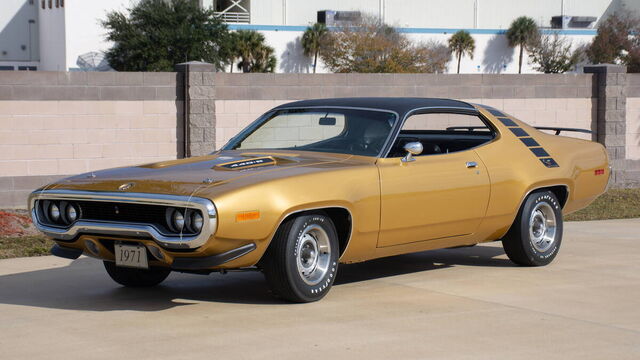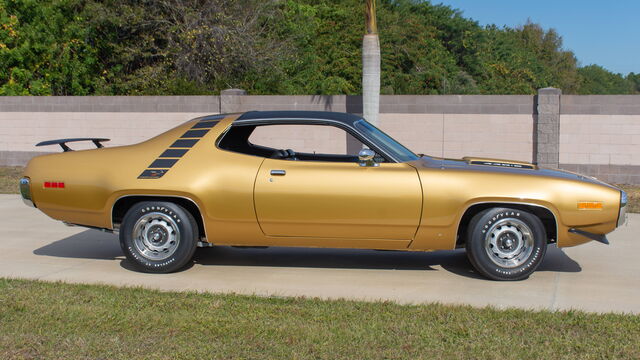Photos:
Click the Image to Zoom
Technical Specifications:
- Year: 1971
- Make: Plymouth
- Model: Road Runner
- Engine: 440 ci/390 hp
- Transmission: 4-Speed
- Body Style: 2dr coupe
- Exterior Color: Light Gold
- Interior Color: Black
Details:
- Original broadcast sheet
- 1 of 137 V-Code 440 Six Pack 4-Speed Road Runners produced in 1971
- Six Pack 3x2 carburetors
- Pistol Grip shifter
- Chrome mirrors, rear spoiler
- Rallye road wheels
- Goodyear Polyglas GT tires
- Black vinyl top and stripes
- Featured in Muscle Car Enthusiast October 2006
- Nut and bolt rotisserie restoration
The year 1971 brought significant change to the American muscle car, with a number of model redesigns appearing. One was the release of the 2-door G-series Chrysler B-bodies, including the Charger/Super Bee and GTX/Road Runner muscle cars. At the time, few foresaw how close to the end of this era the Big Three manufacturers were. In fact, the 1971 model run was also the end of the high-performance equipment as originally optioned on this beautiful 440 Six Barrel Road Runner.
This body was called the ‘fuselage’ style and featured much smoother, more dramatic edges than previous renderings of the classic Plymouth. This was the direct result of ongoing aerodynamic testing that Chrysler had been involved in, and it proved apt on the NASCAR circuit, where this design took Richard Petty to 21 event crowns and the first-ever Winston Cup title that season.
On this car, painted Y4 Light Gold, the formal-type partial vinyl top is augmented by a black rear-angled strobe graphic that laced over from the top and ended in Road Runner logos on each side. The factory front and rear spoiler package only adds to its appeal as raw yet respectable power. While the color itself lends to this car’s attraction, other visual points of interest are hood tie-down pins, chrome sport mirrors, raised white-letter Goodyear Polyglas tires and Rallye wheels.
While the styling change did end production of convertibles, high-compression engines were still available—among them the Hemi, the 340 and the one-of-just-137-built 440 Six Barrel models like this car. Shortened to 6BBL in Plymouth nomenclature, the big engine was rated at 385 HP in 1971, featuring three Holley 2-barrel carburetors atop a semi high-rise intake manifold. Flow-rated at more than 1,000 CFM, this trio would open based on engine vacuum and simply blur the entire vision of anybody inside the car as it accelerated, coupled to the roar of air being pulled in and screaming rear tires. Callouts on the stylized hood let everyone know that sissies need not apply.
This car came with the A833 4-speed transmission, ably shifted with a long-handled Hurst Pistol Grip. The car also has the standard Road Runner bench seat, podded instrument cluster and radio. A Dana 60 differential is under the rear end, visible behind the factory-slotted chrome tips and rear valance blackout graphics.
We mentioned this was the end. Though Road Runner continued on for 1972, the code-E87 Six Pack engine died at year’s end with its boots on, with solid 10.5:1 compression and visible notoriety. Coupled with low production numbers, the desirable 4-speed/Dana driveline, a nut-and-bolt refreshing by Aloha Automotive that is stunning from any angle and the original broadcast sheet, this car showcases the very end of Detroit’s legendary supercar era.
















